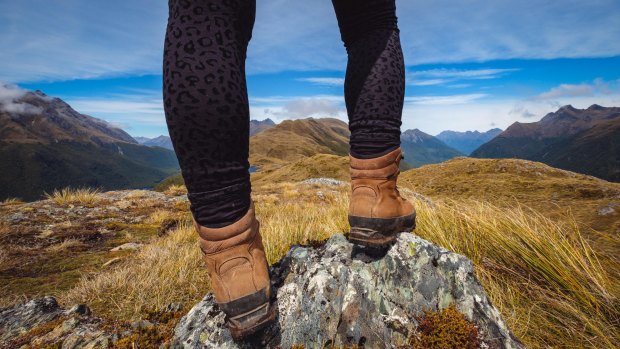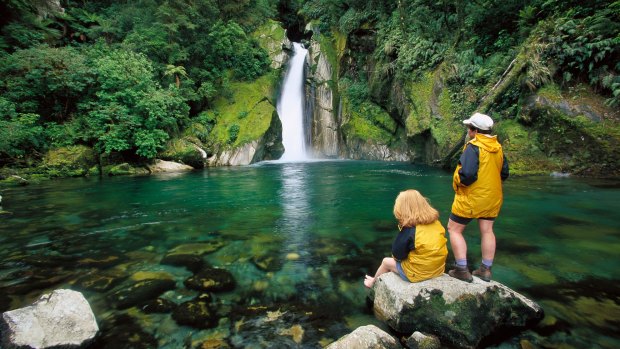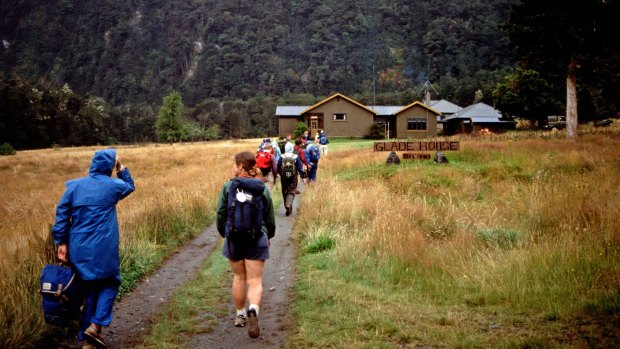This was published 6 years ago
Milford Track, New Zealand: Have tourists ruined the 'finest walk in the world'?

With approximately 7000 visitors a year walking "the finest walk in the world", the Milford Track is not an obscure destination.Credit: Alamy
I wanted to walk until I was physically exhausted and mentally calm. And I wanted to walk alone.
I work in the hum of a hundred electronic feeds, and my job is unscrambling the signals in the noise. So when it was time to unplug, I needed to get well out of radio range.
That's why I was on a little speedboat churning down Lake Te Anau one overcast afternoon, after flying to Queenstown, taking a two-and-half-hour bus and another half-hour van trip to the jetty. With me was a backpack stuffed with four days worth of food and supplies, as I didn't feel I could justify the luxury of the track's lodges and showers and meals while my husband stayed at home, working late to project deadlines.

Two hikers relaxing at Giant's Gates Falls.Credit: Alamy
Besides, the camaraderie and simplicity of the huts appealed. I wanted to be alone but not too alone, and I wanted to see if I could do it by myself.
It has been 130 years since explorers Quintin McKinnon and Ernest Mitchell first scouted an overland tourist route across the Fiordland mountains to Milford Sound in 1888, tracing older Maori routes up to the pass now called Mackinnon Pass (yes, spelled differently) and down into the Arthur Valley to meet the track forged from the sound by Donald Sutherland.
McKinnon, a rugged Scot immigrant who ferried both sightseers and mail to Milford Sound, was the prototype of the conservation department's guides, who these days tramp the paths at improbable speeds, maintaining the paths, shelters and loos along the way.

Hikers starting on the Milford Trek at Glade House.Credit: Alamy
With approximately 7000 visitors a year walking "the finest walk in the world" (as it was first described back in 1908), the Milford Track is not an obscure destination. Indeed, recent reports suggest that the journey has been destroyed by foreign tourist hordes who don't deserve to walk in beauty.
Yet the number of "independent walkers" during the season has been capped to a maximum of 40 a day for many years. As the track can only be walked east to west, it's still possible even in peak months to walk for a while in solitude, catching up with others only in passing.
Walking the Milford is never a spontaneous decision. Each spring-to-autumn season is booked out months in advance, so everyone I'm walking with is a planner. We all set calendar alerts back in May and persisted as the site crashed from the surge in demand.
I land at Glade Wharf with 11 others, the day's last landing of the 38 people with whom I would share meals and dormitories for three nights. Some I would get to know, others would remain a mystery.
There are no name tags, no bonding exercises, no count-offs. On the track, it doesn't feel right to quiz people on their jobs, their families, their plans. We've all left that behind for now.
It's an international crew: ex-army Israelis seeing the world; three families (Dutch, Canadian, Kiwi, with children from eight to adult); 50-something Australian women on a holiday from their families; couples forswearing intimacy for scenery; and a few solo travellers from Ireland, France, Japan, Australia and yes even New Zealand.
Some of us – all the Kiwis, the iron-legged Israelis, the Irish ski instructor, the French athlete – are trail-hardened. Others, like me, are on their first ever multi-day full pack walk. Mileage varies but the track is not beyond anyone with a good pair of boots and a few solid walks' worth of experience.
It's billed as four days but it's really three and a half. It's only five kilometres alongside the emerald green Clinton River to the first stop, Clinton Hut.
I hunt for a lower bunk in one of the two dorms, which remind me of school camps long ago, minus the teen angst.
Still restless, I double back down the path to a boardwalk through the wetlands. It rains one in three days in Fiordland but not lately: the mosses on the trees and flowers in the path are paper-dry.
Maybe walking independently has been false economy. I bought a proper hiking backpack, arguing that I'd save on physiotherapy bills. I needed a water pack, a billy, camp bowls. I'd seen so many Instagram pictures of hikers up to their knees in floodwaters, I spent a bomb on ways to stay dry – raincoat, rainpants, pack cover, pack liner, extra waterproofing.
As a day hiker I'd been dubious about trekking poles – they seemed kind of embarrassing and… elderly. But I became an instant convert the day someone loaned me their poles as I inched down a slope at Werribee Gorge. I could balance. I could navigate steep slopes. And at the end of the hike, nothing hurt.
The real walking begins on the second day, 16 kilometres to Mintaro Hut, halfway up the mountain.
The morning starts in fairytale forests of beeches and ferns and mosses, the trail carpeted in white blossoms like a wedding party. Then the canopy gives way to a "prairie" carved out by a landslide back in 1982, dotted with icy lakes, with wekas hustling their chicks through the meadows.
The real hiking begins at the Bus Stop – a sly name for the final shelter before the path starts to climb, opening onto a giant cascade of rocks where tiny pink ribbons mark a precarious route.
Mintaro is the loveliest of the huts, almost a chalet, with an airy bunk room upstairs beneath a steep roof. From the window near my vinyl mattress, I look down on the timber helipad and across to the mountains, capped with snow even in January. The air is sharp but light doesn't fade from the sky until 9.30 at night.
We all hang our boots up high above the verandah to stop the keas, alpine parrots, from stealing or destroying them. As I sit at a bench, rubbing tiger balm into my feet, I wonder about the poor hiker who discovered this the hard way.
Afternoons and evenings at the huts are low key, mostly concerned with hiking's busywork, the unpacking and cooking and cleaning and repacking. We wash our faces at sinks in unisex bathrooms or soak our feet in icy lakes. We eat rehydrated meals at communal benches, then families play card games while others gossip, stretch or go to bed early with ear plugs and a novel. Maybe that was me.
The third day is the real payoff, 14 kilometres over the Mackinnon Pass and down to the Arthur Valley on the west of the divide. It begins cold and misty and I can't see far ahead as the narrow granite track zigzags up the mountain. The drop over the edge seems sheer, even when a grey mist hides everything.
All views are lost in swirling, snowy cloud by the time I make it to the MacKinnon memorial cairn, erected in the memory of that dogged Scot after the wreck of his boat was discovered in Lake Te Anau.
I don't go anywhere near the cliff face known as 12-Second Drop, unable to see the verge in thick fog. Instead, I crawl under a rocky outcrop to fumble in my pack for every warm item of clothing I've brought. Even so, it's bleak, eerie going across the saddle for another half hour until I get to the Pass Hut, a proper cabin with plumbing and a gas cooker, now filled with shivering hikers.
Burly green keas with feather coats thick as puffer jackets perch outside the windows, chattering beside the toilet and eyeing our kit with the practiced eye of vandals.
Soon enough, the clouds are ripped apart by the sharp winds, revealing the snaggletooth peak of Mount Balloon ribboned with snow.
It's time to move on. As the mists roll away between the peaks, I get the most extraordinary, dynamic, panorama of the alpine valleys, colours changing as the sun strobes behind fast-moving clouds.
The air is fresh and sweet now, the slopes carpeted in mountain daisies and buttercups and weird mosses that look like corals. Waterfalls and rapids roar past between the boulders and keas circle above, laughing at us.
This is followed by a vertiginous staircase, steeper than a high-rise fire escape, that follows the glacier waters of the Roaring Burn as it tumbles towards a deep aquamarine pool.
Not all the day is so rewarding. There are a solid two hours gingerly making my way down rock scrambles, gradually stripping off my merino layers until I'm hiking in a T-shirt and shorts in hazy summer humidity.
In the valley, I dump my pack at Quintin Shelter – right near the third luxury lodge – and take the 90-minute side trip to see the mighty Sutherland Falls up close, a 580-metre drop. Even though this involves another climb, without my pack I feel like I've shifted to a planet with lighter gravity.
The final day's walk is the longest, 18 kilometres, but also the easiest, wide paths and gentle slopes. The guide at the Dumpling Hut has scolded us all in advance for rushing towards the jetty to catch the boat across the Milford Sound rather than stop and discover along the way.
I'm short on sleep and a little dizzy, relieved that this is not another day of steep gradients and loose gravel. Some of the bridges swing vigorously as I cross, or perhaps I'm starting to sway on my feet.
I stop at Mackay Falls to crawl under Bell Rock, hollow within and hovering above the ground through some balancing trick that doesn't merit thinking about. In my final hours, I get sentimental about the towering green forests buzzing with insects and birdsong, knowing I will soon be back in concrete city canyons soundtracked with car horns and phone calls.
I've been walking alone but many of us arrive within minutes of each other at the picnic shelter at Giant Gate Falls, 90 minutes' walk from the jetty. This is the last cascade and the last ultramarine pool.
Some strip off and go for the final, bracing swim, but I'm finally ready to leave. I walk the final stretch in the company of other walkers, stopping to photograph the old mile posts that mark the route – 33 mile posts for the 53.5 kilometres we've walked. Miles are good to walk. They feel more earned, somehow, that the quick click of kilometres.
The final walk is all about the timing. The end is named Sandfly Point, and nobody wants to linger there with the tiny, blood-sucking guardian swarms of Fiordland.
As we reach the end of the path, we all clap and cheer and take photos of each other, then flee inside the last shelter to escape the bites. Maybe it was just luck of the draw, but the 38 strangers on this track have been cordial and kind to each other along the way.
Did we ruin the track by walking it? None of us would have wanted that. We've all carried out everything we brought in, right down to food scraps. Perhaps some day soon they'll restrict access even further, to keep it safe. I'm sure we're all glad we saw it when we did.
As the little orange speedboat churns across the Milford Sound towards the bus that will take us to showers and soft beds and civilisation, I turn back to wave goodbye to the mountains we've crossed.
TRIP NOTES
MORE
FLY
Various airlines fly from Australia's eastern capitals into Queenstown including Air New Zealand, Qantas, Virgin Australia and Jetstar.
WALK
Book the huts for three nights for the 2018/2019 season from May at http://www.doc.govt.nz/parks-and-recreation/
The NZ Department of Conservation will give an update on when bookings will open in early April.
Ultimate Hikes has exclusive rights to lodges for 5-day catered walks on the Milford Track.
The writer travelled at her own expense.
Sign up for the Traveller Deals newsletter
Get exclusive travel deals delivered straight to your inbox. Sign up now.